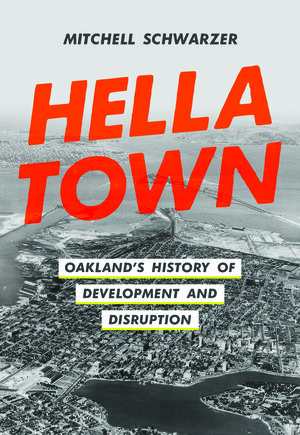By Mitchell Schwarzer, author of Hella Town: Oakland’s History of Development and Disruption
It was the spring of 1964 and the sea air caressed my face as my father drove us along the Belt Parkway in Brooklyn. He pulled off to a rest stop. We got out of the car and raced to the shoreline. “You see the Verrazano, Mitchell. It’s almost finished. Soon it will be the longest suspension bridge in the world, over 4000 feet. In 1949, when we arrived in America on a ship from Germany, this is how we came into New York Harbor, but there was no bridge.”
By this point, not yet seven years old, I was used to my immigrant father rhapsodizing on the modern landmarks rising in New York City. As he drove and spoke, I would look up at the 32-story buildings of the Bridge Apartments straddling the expressway on the approach to the George Washington Bridge and wonder how the concrete platform could possibly hold them up. In Queens, I would follow the roadways, ramps and overpasses of three expressways and parkways coming together, intertwining and then, miraculously, parting ways. Through his guidance, New York’s landscape became a museum of engineering feats.
By my teen years in the early 1970s, other experiences intruded. We’d be driving to Brooklyn from Long Island, or along the same sunken Cross-Bronx Expressway toward the Bridge Apartments and my father would remark on the rows of dilapidated buildings along our route. When I became more independent, I took the subway to the ends of each line, getting off and exploring the underside of post-war progress, wondering how New York City could evoke both utopia and dystopia.
Over the decades that followed, the gulf of an urban America divided by prosperity and poverty stayed with me and guided my research, writing and teaching. I studied the development of transportation technologies alongside restrictive racial covenants and red-lining. I wrote on how the era of massive government-led planning was succeeded by community-driven (and eventually Nimby) reaction and the privatization of new projects. And as I was investigating cities, they were changing before my eyes. Who, in the 1960s, could have imagined that a wave of immigration from the global south would wash over American urbanity and revitalize scores of emptied-out districts? Who could have foreseen whites moving in large numbers into black neighborhoods, leading to the phenomenon of gentrification?
Settled in Oakland, California for many years now, I have come to see that the East Bay city, whose population is only one-twentieth of New York’s, parallels many of the latter’s rises and falls; our once-ascendent freeways, BART system and extensive urban renewal programs; our hollowed commercial streets and vanishing industry. By the time I moved to Oakland in 1981, it had fallen on hard times. Minority districts, from West to East Oakland, evoked the wastelands of the South Bronx and Brooklyn’s Brownsville. Downtown movie theaters had turned to pornography like Times Square and the vacant streets felt unsafe after dark. But in encounters that dipped into the town’s collective memory, I realized that Oakland’s decline had been recent, just like New York’s. Retailing and industry had once flourished. Top-down government plans had tried to ameliorate the subsequent decline, but often made matters worse. Still, by the early twenty-first century, Oakland was rising again, following a path New York had taken a couple of decades earlier. And the greater Bay Area, like its east coast counterpart, was similarly struggling with traffic congestion, skyrocketing housing costs and economic inequality.
In researching and writing Hella Town: Oakland’s History of Development and Disruption, I’ve learned that most of the structural circumstances that underlie urban upturns and downturns are common to cities across the country, caused by changes in: transportation and communications technology; economic cycles; demographic composition; individual attitudes and group actions regarding class, race and religion; environmental norms. My experiences in New York still strike home because the stories I have uncovered about Oakland are not different in kind, but rather different in scale and detail. The urban ride here is as thrilling, bumpy and full of surprises as the one I grew up with and its lessons as relevant to the future of cities across the nation.
